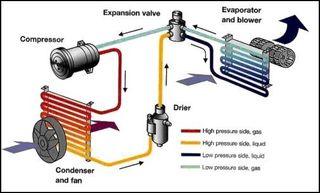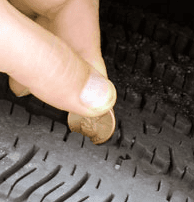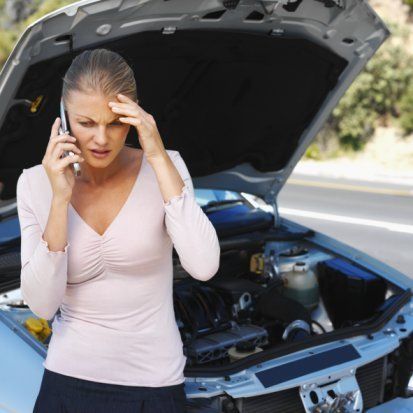Is your car cool? Here are some reasons your AC isn't working!
It's a sticky situation (literally!) when you hop into your car on a hot, humid Grand Rapids day and turn on the AC, only to have it blow more hot, humid air on you. That is, if it even works at all! So why might your ac break? Let's take a look at how it works in the first place.
Let's keep in mind a few basics of how physics work. It will help the rest of this make sense. If at any time you feel this is too much, don't worry, you can always request an appointment to have us take a look.
- Heat will always flow to colder areas.
- Heat spreads out to less-warm areas until everything is the same temperature.
- Cold does not make warm things cooler—the heat moving from a warmer object to warm up the cooler object just makes it seem that way.
- Pressurizing a gas makes it turn to liquid faster.
- Depressurizing a liquid makes it turn to a gas faster.
- Material with more surface area will change temperature faster than material with very little surface area.
- Making parts of a material flatten out (like a condenser's fins) gives it more surface area.
- Vapor will condense around something colder than the surrounding air, like with a cold can of soda.
- Liquid will evaporate when it reaches a certain temperature, which causes whatever it is evaporating off of to cool off (like when you get out of the shower and you feel cold as all the water evaporates off of your skin).
So now let's set up our air conditioning unit. First, we have your coolant. Freon used to be the go-to coolant, but because of environmental concerns, it has been phased out and replaced with R-134a.

Buying brand new tires can be an intimidating task, much less buying used tires. Used tires have the possibility of being too used, risking damage to yourself, your car, or even others. So what can you do to ensure that you are buying safe, dependable used tires?
Looking up reviews about a tire store is always a good start. See what the general consumer consensus is about the shop. Do they treat their customers well? Do they go above and beyond the basic level of service? Are they dependable and fair? If so, then they're worth looking into buying used tires from. If they seem like they take cheap shortcuts and cause more problems for their customers than they fix, you might want to keep looking.
Once you've determined a good place to shop, you'll want to take a look at the actual tires.
Fist, make sure you're looking at the correct size tires for your car. The size of the tire is shown on the side of the tire and usually starts with P or LT. It's always a good idea to check your car's manual instead of assuming that your current tires are the correct size. If you don't have a car manual, you can also check for a metal tag in your driver's door jamb, your glove compartment door, or your fuel hatch.
Once you're looking at the right tire size, then check the physical condition of the tire for this possible wear and tear.

Wear Distribution
So now that you have determined how much wear there is on the treads, check for how the wear is distributed. It should be even across the face of the tire. Be wary of wear that is only on one side of the tire, is only in the middle of the tire, is only on one place on the tire, or is in spots across the tire (cupping). Also look for bubbles or pockets of air underneath the rubber of the tire. Uneven wear diminishes the effectiveness of a tire and can be dangerous to use.
Matching Treads
Try to find treads that match, whether this is replacing one tire and matching it to your other tires, or finding four tires that all match each other. Having tires with the different treads can reduce the effectiveness of the tires as a set, causing more wear or dangerous driving conditions.
Punctures/Patching
Check the sides (and insides, if you can) of the tire for patches, plugs, etc. If a tire has several repairs done to it, it's probably an indicator of a problem tire.
Leo and Ed's proudly offers only the top quality used tires. We would be more than happy to help you find the perfect used tires for your car, keeping you, your family, and your friends safe, happy, and confident in the tires on your vehicle!

You're ten minutes late for work, fishing your keys out of your purse as you race out the door towards your car. You jump into the driver's seat and jam the key into the ignition, but your car doesn't start. Why not? Why on Earth does it have to pick right now, of all times, to not start?
Rhetorical question aside, it might help to understand how your car works before we delve into why it doesn't work.
These are some basic reasons why your car might not be starting. If your engine won't turn over, the fellows here at Leo and Ed's Auto in Grand Rapids will be able to run diagnostics on your car and find out what's wrong with it. We will get your vehicle fixed so you can get back to your normal routine!

